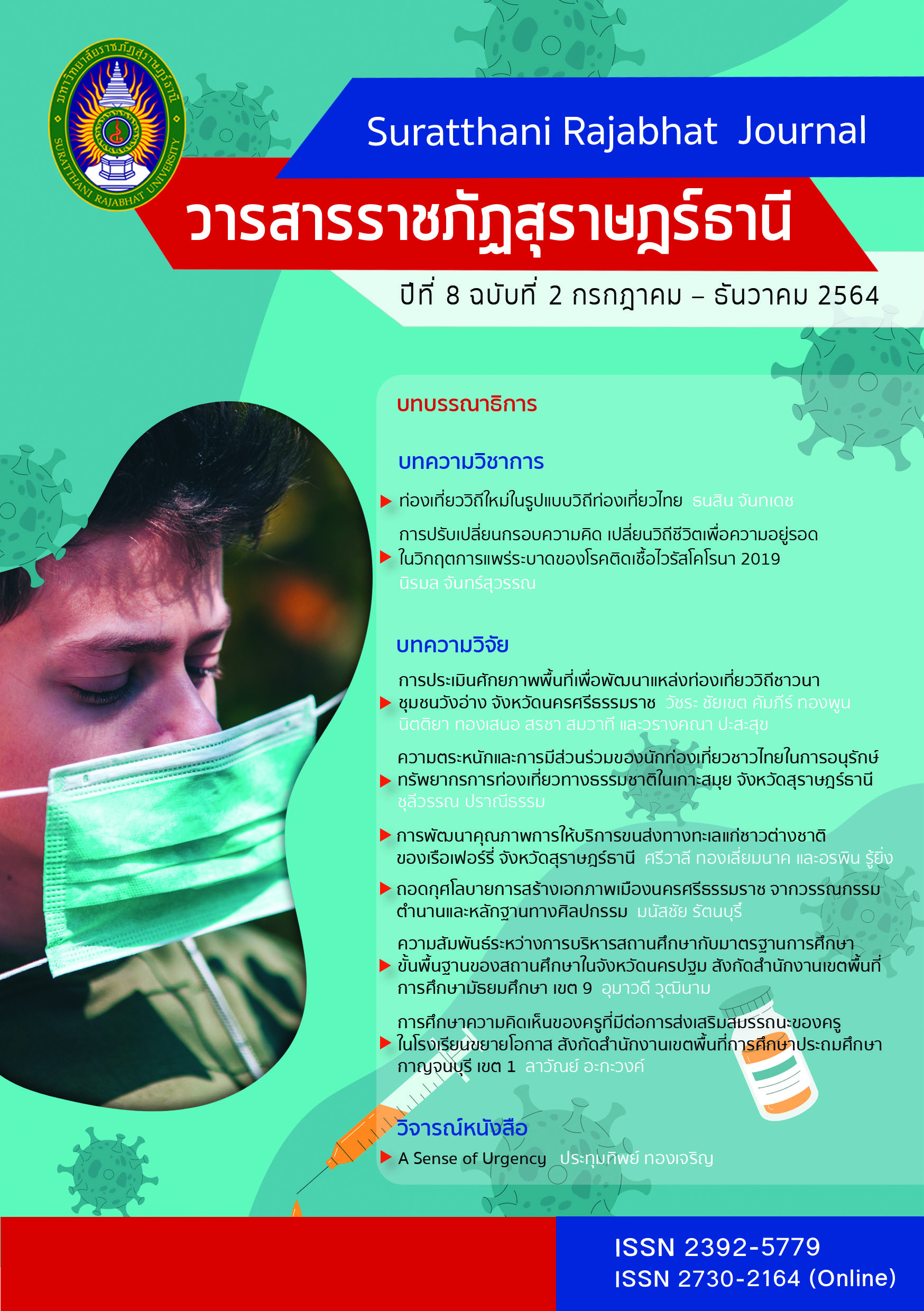Deciphering the Stratagem of Creating Unity within Nakhon Si Thammarat through Literature, Legends, and Art as Evidence
Main Article Content
Abstract
This research paper is based on the preliminary observations of the dissertation outline, the strategy and the legend of Nakhon Si Thammarat, to devise ways to create a surreal thought process in contemporary visual arts. This research paper breaks down the contents from some of the 3 chapters of the dissertation about the deciphering the stratagem of creating unity within Nakhon Si Thammarat. Also, from literature, legends and artistic evidences. The purposes of this dissertation are to analyze the legend of Nakhon Si Thammarat from the structural essence of legends and artistic symbols through the analytical process, to interpret the content and paraphrase the conceptual meaning and to decode various from creating the unity of Nakhon Si Thammarat through a stylistic approach to linguistic and symbolic structures, with the aim of summarizing the results of the qualitative research. The methodology for this research is to relevant documents and interviews to analyze and interpret to find the essence of the content structural from language, discourse, and from the analysis symbols from artistic evidences in Nakhon Si Thammarat, then analyzed by using the social structure theory, folkloristic and the semiology then applied the knowledge gained to synthesize and create a creative designs into mythological paintings in a new content. The result shows that a social structure linked to the views of fine arts and literature, it acts as a medium between the past and the present to communicate the implications of our ancestors that acts as a strategy to create a spiritual connection passing on rituals that contains goals and implications. This makes interpretation of stories from the past in the present context, making it worthwhile to study the wise wisdom from the ancestors in Nakhon Si Thammarat.
Article Details
References
ฉัตรชัย ศุกระกาญจน์. (2559). ประติมากรรมโดดเด่นในวัดพระมหาธาตุวรมหาวิหาร (ตอนที่ 3). http://phrama hathat- heritage.com/2016/12/12
ธิดา สาระยา และนงคราญ สุขสม. (2554). รายงานการสัมมนาประวัติศาสตร์นครศรีธรรมราช ครั้งที่3. โรงพิมพ์ไทม์พริ้นติ้ง.
นงคราญ สุขสม. (2545.) ประวัติศาสตร์และโบราณคดีสุราษฎร์ธานี. นครศรีธรรมราช: สําานักงานโบราณคดีและพิพิธภัณฑสถานแห่งชาติ.
บัญชา พงษ์พานิช. (2552). โลกของอิสลามและมุสลิม ในสยามประเทศไทย-อุษาคเนย์-
เอเชียตะวันออกเฉียงใต้. มูลนิธิโครงการตำราสังคมศาสตร์และมนุษยศาสตร์.
ปรีชา นุ่นสุข. (2540). ประเพณีสารทเดือนสิบ. องค์การค้าของครุสภา.
พิเชฐ แสงทอง. (2559). ตำนานและเรื่องเล่าปรัมปราท้องถิ่นภาค : ใต้อัตลักษณ์ วัฒนธรรม อำนาจ และการต่อต้านในประวัติศาสตร์ความเป็นไทย. ยิบซี กรุ๊ป.
โรล็องด์ บาร์ตส์. (2555). มายาคติ. โครงการจัดพิมพ์คบไฟ.
มูลนิธิหอจดหมายเหตุพุทธทาส อินทปัญโญ. (2561). คัมภีร์พระนิพพานโสตร “ตำนานแห่งพระบรมธาตุ” เมืองคอน ณ วัดวังตะวันตก. บริษัท พิมพ์ดี จำกัด.
ศิราพร ณ ถลาง. (2557). ทฤษฎีคติชนวิทยา วิธีวิทยาในการวิเคราะห์ตำนาน – นิทานพื้นบ้าน. จุฬาลงกรณ์มหาวิทยาลัย.
สุภางค์ จันทวานิช. (2559). ทฤษฎีสังคมวิทยา. จุฬาลงกรณ์มหาวิทยาลัย.
ศุภิสรา ปุนยาพร. (2556). คนไทยถือข้อห้ามอย่าทำ. ไทยควอลิตี้บุ๊คส์ (2006), บจก.
Strauss, C.L. (1908–2009). The apotheosis of heroic anthropology.
บุคลานุกรม
พระครูเหมเจติยาภิบาล (ผู้ให้สัมภาษณ์). มนัสชัย รัตนบุรี (ผู้สัมภาษณ์) ที่ วัดพระนคร ตำบลในเมือง อำเภอเมือง จังหวัดนครศรีธรรมราช 80000. เมื่อวันที่ 30 เดือนธันวาคม 2562.


